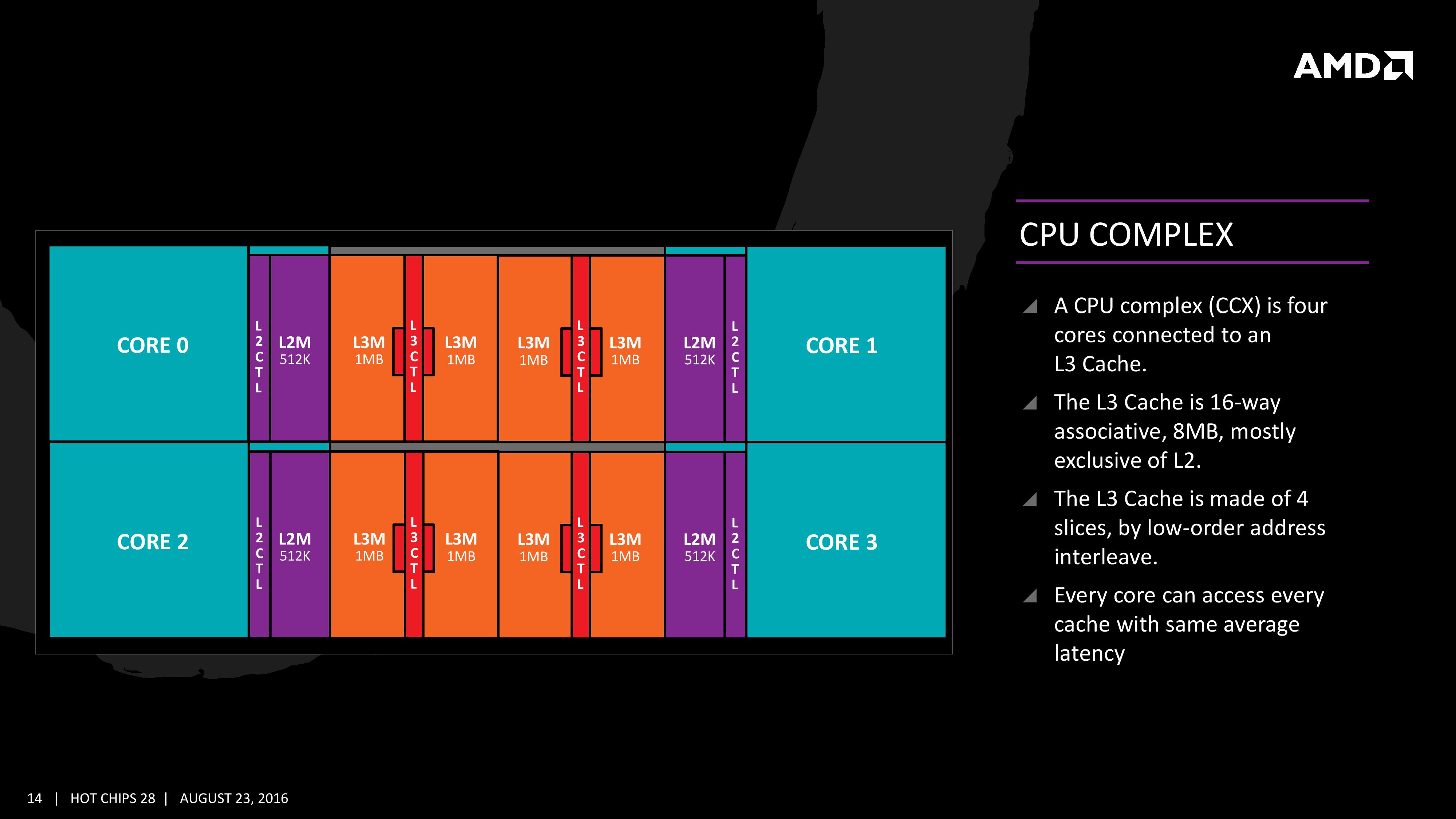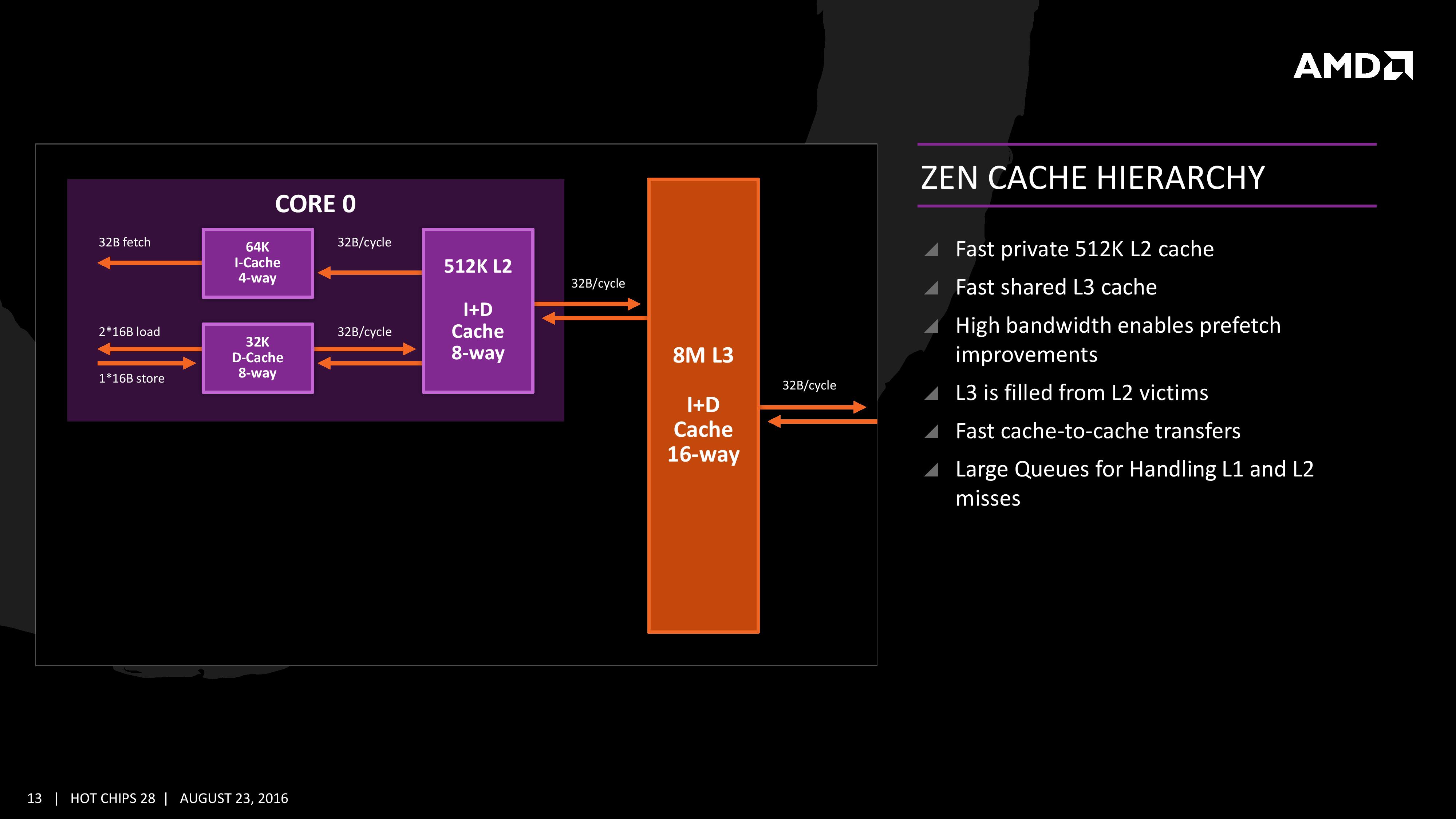AMD Zen Microarchiture Part 2: Extracting Instruction-Level Parallelism
by Ian Cutress on August 23, 2016 8:45 PM EST- Posted in
- CPUs
- AMD
- x86
- Zen
- Microarchitecture
The Core Complex, Caches, and Fabric
Many core designs often start with an initial low-core-count building block that is repeated across a coherent fabric to generate a large number of cores and the large die. In this case, AMD is using a CPU Complex (CCX) as that building block which consists of four cores and the associated caches.
Each core will have direct access to its private L2 cache, and the 8 MB of L3 cache is, despite being split into blocks per core, accessible by every core on the CCX with ‘an average latency’ also L3 hits nearer to the core will have a lower latency due to the low-order address interleave method of address generation.
The L3 cache is actually a victim cache, taking data from L1 and L2 evictions rather than collecting data from prefetch/demand instructions. Victim caches tend to be less effective than inclusive caches, however Zen counters this by having a sufficiency large L2 to compensate. The use of a victim cache means that it does not have to hold L2 data inside, effectively increasing its potential capacity with less data redundancy.
It is worth noting that a single CCX has 8 MB of cache, and as a result the 8-core Zen being displayed by AMD at the current events involves two CPU Complexes. This affords a total of 16 MB of L3 cache, albeit in two distinct parts. This means that the true LLC for the entire chip is actually DRAM, although AMD states that the two CCXes can communicate with each other through the custom fabric which connects both the complexes, the memory controller, the IO, the PCIe lanes etc.
One interesting story is going to be how AMD’s coherent fabric works. For those that follow mobile phone SoCs, we know fabrics and interconnects such as CCI-400 or the CCN family are optimized to take advantage of core clusters along with the rest of the chip. A number of people have speculated that the fabric used in AMD’s new design is based on HyperTransport, however AMD has confirmed that they are not using HyperTransport here for Zen. More information on the fabric may come out as we nearer the launch, although this remains one of the more mysterious elements to the design at this stage.
The cache representation in the new presentation at Hot Chips is almost identical to that in midweek, showing L1 and L2 in the core with 8MB of L3 split over several cores. AMD states that the L1 and L2 bandwidth is nearly double that of Excavator, with L3 now up to 5x for bandwidth, and that this bandwidth will help drive the improvements made on the prefetch side. AMD also states that there are large queues in play for L1/L2 cache misses.












106 Comments
View All Comments
tipoo - Wednesday, August 31, 2016 - link
Bulldozers engineering samples were 2.5GHz and that shipped stupid high clocked. Zen ESs being 3GHz doesn't worry me.Cooe - Thursday, May 6, 2021 - link
Holy CRAP did history ever make you look like an absolute freaking idiot! xDextide - Monday, August 29, 2016 - link
Well, they have already shown an 8-core Zen running at full load at 3Ghz with their regular OEM heatsink/fans, and those are rated at 125W TDP max, so we do already know that's possible.defter - Wednesday, August 24, 2016 - link
It's 40% IPC improvement, not 40% overall improvement. If you improve IPC by 40% and achieve 85% of the clock speed, the total improvement will be only 20%.Since AMD hasn't talked about clock speed we can assume that it will be lower than Bulldozer.
euskalzabe - Wednesday, August 24, 2016 - link
Let me fix that for you: "Since AMD hasn't talked about clock speed we can assume..." absolutely nothing and can only wait until the final product is released.retrospooty - Wednesday, August 24, 2016 - link
Actually he is right and probably understating it. If AMD says it qill have 40% IPC improvement, it is probably not true, or true only in a few select benchmarks. If AMD left out the clockspeed it is almost definitely going to lower. AMD has zero credibility with pre-release performance claims. Nothing AMD says can be takes at its word until retail units (not engineering samples) are independently tested.Azix - Wednesday, August 24, 2016 - link
why the flying fork would the clock speed be lower? I hope you dont mean lower than they have shown, that would make no sense.Bulldozer engineering samples were maybe 2.5Ghz or 3Ghz. Additionally, talking about actual clock speeds would be to give away sku information. How they plan to structure the product line etc.
Outlander_04 - Thursday, August 25, 2016 - link
Both intel Broadwell-e and Zen were at 3 Ghz for the comparison .Broadwell-e maxes out at 3.6 Ghz , but most models are at 3.2 Ghz .
Dont let your prejudices cause you to jump to conclusions.
Zen could easily be released running at higher clock rates
silverblue - Wednesday, August 24, 2016 - link
Imagine for a second that Zen was clocked like the FX-8320E, that is a 3.2GHz base with 4.0GHz boost. Would a 40 to 50% average IPC boost make Zen competitive?For all we know, Zen could be conservatively clocked, paving the way for Zen+ with moderate tweaks and increased clocks; a bit like Piledriver vs. Bulldozer, as opposed to Phenom II vs. Phenom.
looncraz - Wednesday, August 24, 2016 - link
Zen will clock very close to 4Ghz out of the box - AMD kept most of the speed-demon elements of Bulldozer, such as the long pipelines. They also used dedicated, simple, schedulers - which is where frequency limits are frequently found... and they also put the L3 cache on a different clock bus, meaning it might operate at a different frequency from the cores... again.The engineering samples are always clocked low, so if they are running at 3Ghz for a demo, then they will be able to achieve at least 3.4~3.6Ghz, with 4Ghz boost clocks on eight-core CPUs. Quad core units will obviously go higher, still. That is why half the cores still has 70% of the power draw - it's operating higher up the frequency curve. 3.8Ghz base, 4.2Ghz boost for the top quad core SKU seems very likely given what is known.